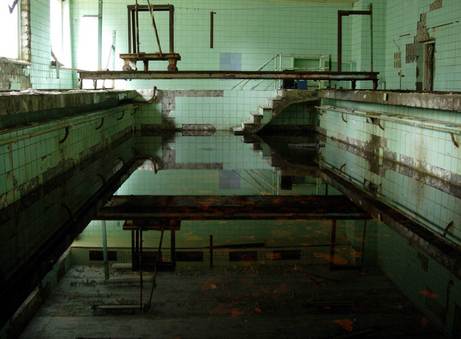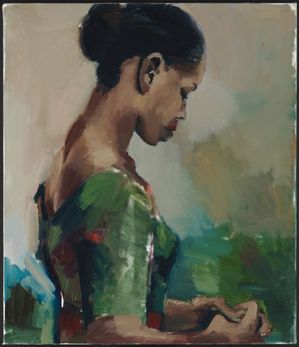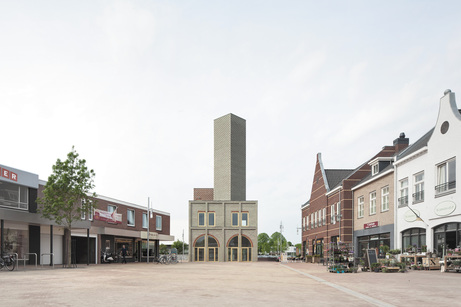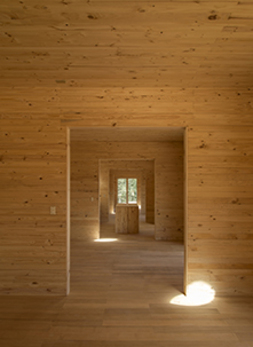Pezo von Ellrichshausen, "Casa Meri," Florida, Chile, 2014. Photo courtesy Pezo von Ellrichshausen.
No More No Less
Pezo von Ellrichshausen
Apr 20, 2017
(6pm)
Talk
Please RSVP
In conjunction with the Graham Foundation’s current exhibition, Spaces without drama or surface is an illusion, but so is depth, Mauricio Pezo and Sofia von Ellrichshausen discuss their work and participation in the show, including No More No Less, a multi-year project in which the architects represent their work within the rooms of a miniature museum.
Through a selection of Pezo von Ellrichshausen’s buildings, paintings, drawings, photographs, and scale models, the lecture explores the fundamental—yet diffuse—distinction between presence and representation.
Pezo von Ellrichshausen is an art and architecture studio founded in 2002 in Concepción, Chile, by Mauricio Pezo and Sofia von Ellrichshausen. They currently teach at the Universidad Catolica in Santiago and at the Illinois Institute of Technology in Chicago. They have lectured at the Tate Modern, London; the Victoria & Albert Museum, London; the Metropolitan Museum of Art, New York; the Alvar Aalto Symposium; and Harvard University’s Graduate School of Design, Cambridge; among other venues. In 2008 they curated the Chilean Pavilion at the Venice Biennale.
For more information on the exhibition, Spaces without drama or surface is an illusion, but so is depth , click here.

Stanley Kubrick, [Commodities traders on the floor of the Chicago Board of Trade], Look, 1949
The Jungle: Bertolt Brecht’s Chicago and the Architecture of Production
Francesco Marullo
Apr 11, 2017
(6pm)
Talk
Please RSVP
Despite having never visited the city, Chicago was an obsession for Bertolt Brecht (1898–1956). He viewed Chicago as a metropolis built on sheer rationality and steel-frames, grain-silos and financial speculation, infrastructure and industrial monopolies, nomad workers and labor struggles—the material expression of the most advanced forces of capitalism. Brecht allegorically adopted such a jungle of asphalt, railways, skyscrapers, primitive drives, and frantic activities to stage most of his early plays. By dissecting reality “like the mechanism of a car,” Brecht’s theatre rejected any emphatic representation of the world, aiming instead to unravel the conditions which produce the world. This talk reads the architecture of production in Chicago through the eyes of Bertolt Brecht, adopting the principles of estrangement, dialectical theatre, and montage as design tools for conjecturing a series of projects for The Resistible Rise of Arturo Ui.
Francesco Marullo holds a MS and PhD in History and Theory of Architecture from Delft University of Technology (TU Delft) and The Berlage Center for Advanced Studies in Architecture and Urban Design in Rotterdam. He is a founding member of the research collective The City as a Project (2010), and his work focuses on the relation between architecture, logistics, and production. Marullo is the 2016–17 Douglas A. Garofalo Fellow and Visiting Assistant Professor at the UIC School of Architecture. Previously, he taught at The Berlage, TU Delft, the Rotterdam Academy of Architecture, the RomaTre University, and also collaborated with the Office for Metropolitan Architecture, Matteo Mannini Architects, and DOGMA. In 2012 he cofounded Behemoth Press—a think-tank platform devoted to the exploration of the architectural project in the form of essays, drawings, exhibitions, symposia, and publications.
About the Douglas A. Garofalo Fellowship
Named in honor of architect and educator Doug Garofalo (1958–2011), this nine-month teaching fellowship—supported with a grant from the Graham Foundation—provides emerging designers the opportunity to teach studio and seminar courses in the undergraduate and graduate programs and conduct independent design research. The fellowship also includes a public lecture at the Graham Foundation and an exhibition at the UIC School of Architecture. To learn more about the fellowship, click here.


Jacob Kirkegaard, “AION,” 2016.
Jacob Kirkegaard
Lampo Performance Series
Apr 08, 2017
(8pm)
Performance
Please RSVP
In his first Chicago performance, Jacob Kirkegaard presents AION, recorded and filmed in four abandoned spaces inside the radioactive zone around the former nuclear power plant in Chernobyl, Ukraine.
AION—infinity or eternity in ancient Greek—was inspired by the groundbreaking sound work I am sitting in a room (1969), by artist Alvin Lucier, in which Lucier recorded himself saying, “I am sitting in a room, different from the one you are in now. I am recording the sound of my speaking voice.” He then played these phrases back and recorded them again, until the different layers of his voice began to merge. Kirkegaard has taken Lucier’s action a step further, recording the resonance of an empty swimming pool, concert hall, gymnasium, and church, inside the Chernobyl exclusion area.
Kirkegaard put up a microphone and speaker in each space, started the recording, and left. After ten minutes, he returned, stopped the recording, played it back into the same room, and made a new recording. With each new layer, subtle sounds enlarged and deepened until they turned into one rich hum with many overtones. In effect, he has recorded the voices of rooms.
Jacob Kirkegaard (b.1975, Esbjerg, Denmark) is an artist focused on the scientific and aesthetic aspects of resonance, time, sound, and hearing. His installations, compositions, and performances deal with acoustic spaces and phenomena that usually remain imperceptible. Using unorthodox recording tools, including accelerometers, hydrophones, and home-built electromagnetic receivers, Kirkegaard captures and contextualizes previously unheard sounds from a variety of environments: a geyser, a sand dune, an empty room, a glacier, and even the human inner ear itself.
Based in Berlin, Kirkegaard is a graduate of the Academy for Media Arts in Cologne. He has presented his works at exhibitions, festivals, and conferences throughout the world, including the Museum of Modern Art, New York; Louisiana Museum of Modern Art, Denmark; KW Institute for Contemporary Art, Berlin; Museum of Contemporary Art, Denmark; the Menil Collection, Houston; Rothko Chapel, Houston; Aichi Triennale, Nagoya; and the Mori Art Museum, Tokyo. He has released several albums on Touch, Important Records, and other labels. He is also a member of the sound art collective freq_out.
On Friday, April 7, 6 p.m, Kirkegaard will also give an artist talk in conjunction with this performance at the Lampo Annex, Monadnock Building, 53 W. Jackson Boulevard #1656, to discuss his audio-video work in Chernobyl as well as similar projects in Fukushima and other nuclear power plants. RSVP here
Since 2010 the Graham Foundation has supported and partnered with Lampo to produce this performance series held at the Madlener House. Lampo, founded in 1997, is a non-profit organization for experimental music and intermedia projects.


Lynette Yiadom-Boakye, "The Work," 2015. Oil on canvas.
Lynette Yiadom-Boakye
Northwestern University Dept. of Art, Theory, Practice Visiting Artist Talk
Apr 06, 2017
(7pm)
Talk
Please RSVP
As part of our continuing collaboration with Northwestern University's Department of Art, Theory, Practice, the Graham Foundation is pleased to host a talk by artist and writer Lynette Yiadom-Boakye.
Lynette Yiadom-Boakye is an artist and writer of Ghanaian descent based in London. She is represented by the Corvi-Mora Gallery in London and Jack Shainman Gallery in New York. Her work is included in the permanent collections of a number of institutions including the Tate Collection, London; the Victoria and Albert Museum, London; the Miami Art Museum; the Studio Museum in Harlem; the Museum of Contemporary Art Chicago; the Nasher Museum of Art, Durham, NC; The Museum of Modern Art, New York; the San Francisco Museum of Modern Art; the National Museum of African Art; and the Museum of Modern Art Warsaw. Recently she has mounted solo shows at the Serpentine Gallery, London (2015); Haus der Kunst, Munich (2015); Kunsthalle Basel, Switzerland (2016–17); and the New Museum, New York (May 2017). In 2006, Yiadom-Boakye won the Arts Foundation Fellowship for Painting. In 2012, she won the New Museum's Pinchuk Foundation Future Generation Prize, and in 2013 was shortlisted for the Turner Prize for her 2012 exhibition at Chisenhale Gallery in east London.
This lecture is part of the Department of Art, Theory, Practice at Northwestern University Visiting Artist Lecture Series, and is made possible with generous support from The Myers Foundations and the Jerrold Loebl Fund for the Arts.


Monadnock, "Marketsquare," Nieuw Bergen, 2015. Photo: Stijn Bollaert.
Make No Little Plans
Monadnock
Mar 30, 2017
(6pm)
Talk
Please RSVP
Job Floris, architect and co-founder of the Dutch architecture firm Monadnock, will present a talk about the firm's practice and their participation in Spaces without drama or surface is an illusion, but so is depth, on view at the Graham Foundation February 16–July 1, 2017.
Monadnock is a Rotterdam-based architecture practice led by Job Floris and Sandor Naus. Monadnock designs, researches, writes, and produces discourse in the fields of architecture, urbanism, interiors, and staging. Their work shifts between the scale of the city, the street, and the interior. Monadnock creates contemporary buildings that embed architecture in the cultural production of their generation as a whole. By examining key themes such as the contemporary and tradition, convention and banality, constructive logic, and illusionary representation, Monadnock aims for an architecture that combines beauty, efficiency, and the transfer of architectural knowledge. Landmark, Monadnock's viewing tower project developed for the municipality of Nieuw Bergen (NL), was shortlisted for the 2017 Mies van der Rohe Award.
For more information on the exhibition, Spaces without drama or surface is an illusion, but so is depth , click here.






 PREVIOUS POSTS
PREVIOUS POSTS